Over the course of its long life, Chevy has almost cancelled the Corvette at least twice.
Ford once gave thought to dropping the Mustang.
Yes, really.
Wisely – as it turned out – neither car was given its walking papers when sales temporarily drooped. The people in charge were savvy enough to see the bigger picture; they realized the importance of the presence of these halo cars in the lineup to the sales of their other cars – even when the halo cars weren’t moving particularly well.
A shiny new Corvette looked good as the centerpiece of a dealership’s display. Even if it didn’t sell, it brought in people who drove home in new Malibus. Mustang aspirations got people behind the wheel of Fiestas.
Etc.
The Japanese, on the other hand . . .
Their halo cars come – and go.
Mazda’s RX8, Toyota’s Celica Supra.
And now – it looks like – the Nissan Z car.
Word is that the 2018s will be the last of them. For awhile, at least.
Carpe diem…
The 370Z is Nissan’s two-seat high-performance sport coupe/convertible – the scion of a line that dates back to the iconic 1969 240Z.
It occupies a slot in between more powerful – and more expensive – high-performance coupes/convertibles like the Chevy Corvette and modestly priced but not nearly as powerful sports cars like the Subaru BRZ/Toyota 86 and Mazda Miata/Fiata (the Miata-based Fiat Spider 124).
You can buy a new 370Z with a 332 hp V6 for $29,990 to start – vs. $25,495 for a Subaru BRZ with a 205 hp four cylinder engine.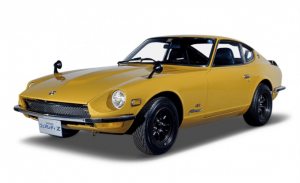
A loaded 370Z Nismo – with an uprated (350 hp) version of the V6, Recaro sport buckets and ultra-lightweight 19-inch NISMO forged alloy wheels wrapped with Bridgestone Potenza S007 ultra-performance tires stickers for $45,690 – vs. $55,450 for the least-expensive/base trim Corvette.
Or – and this isn’t going too far – you could pay $89,400 for a base trim Porsche 911 – and get a 370 hp 3.0 liter six.
A Heritage Edition – available in Chicane Yellow or Magnetic Back – is now available.
It is meant to remind buyers of the early Z cars, especially the original ’69 240, which was also done up in a similar yellow/black paint scheme.
All Zs get revised programming of the drive-by-wire throttle system to make the engine feel more responsive, especially during part-throttle transitions.
Manual-equipped Zs get a new “Light Pedal Effort” high-performance ceramic-metallic clutch developed in conjunction with Nissan’s Motorsports division.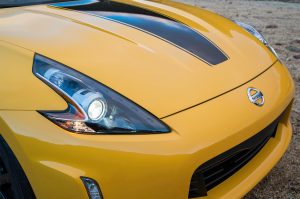
All trims also get blackout headlight treatment with complementary blackout effect tail-lights and rear valance panel.
Inside, the standard audio system gets upgraded to six speakers from four previously.
WHAT’S GOOD
Much quicker than a BRZ, 86 or Miata/Fiata.
Less pricey than a Corvette.
Iconic.
Nissan’s 3.7 liter V6 has an excellent track record for reliability and low-cost upkeep.
If the rumor is true and Nissan cancels the car after the 2018 model year, you’ll own an icon – the last of the line.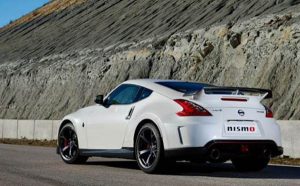
WHAT’S NOT SO GOOD
As thirsty as a V8 Corvette – but not nearly as quick as a V8 Corvette.
Other than the new Heritage Edition styling and the powertrain tweaking, it’s almost exactly the same car this year as it was five years ago.
If the rumor isn’t true – and a redesigned Z appears in 2019 – you’ll own an aged icon. (Like owning an ’81 Trans-Am in 1982, for those who know the reference.)
UNDER THE HOOD
370Z are powered by a 332 hp version of Nissan’s 3.7 liter DOHC V6, paired with either a six-speed manual or (optionally) a seven-speed automatic. The manual is available with computer-controlled, throttle blip/rev-matching downshifts for smoother (and quicker) gear changes. The automatic s available with paddle shifters and learning algorithm software that tailors shift feel/timing to your driving – as you drive. As you get more aggressive, the shift action becomes more aggressive.
The optional Nismo package ups the V6’s output to 350 hp.
Either way, the car gets to 60 in about 5.1 seconds.
The Nismo’s extra 18 hp not making much of a difference as far as the stopwatch goes.
This may be due to the fact that the up-rated engine’s torque output (276 ft.-lbs.) is virtually the same as the non-Nismo’d Z-car’s (270 ft.-lbs.) and the car is fairly heavy – 3,375 lbs. for the coupe.
While hp determines ultimate top speed, it’s torque that gets a car moving.
The Nismo Z does sound tougher, though – due to the lower-restriction exhaust that comes as part of the Nismo enhancements – which also include higher-capacity brakes, strut tower bracing, track day-ready suspension calibrations and a pretty wild-looking GT-R supercar themed body kit with slats and air diffusers.
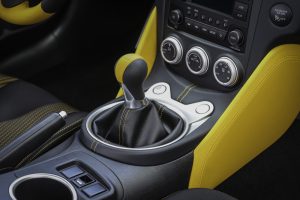 Gas mileage is 18 city, 26 highway with the six-speed manual transmission.
Gas mileage is 18 city, 26 highway with the six-speed manual transmission.
While not terrible for a high-powered sports car, these numbers are about the same as the numbers posted by higher-powered supercars like the current Corvette – which comes standard with a 455 hp 6.2 liter V8 and gets to 60 in just under four seconds.
The Corvette is no lightweight, either – 3,428 lbs. at the curb for the coupe. But its huge V8 produces 465 ft.-lbs. of torque – not far from twice the torque produced by the Nissan’s V6.
That’s why it gets going as quickly as it does.
But on the other side of the coin, the Z massively outguns the under-engined (and under-torqued) Subaru BRZ and its badge-engineered brother, the Toyota 86 coupe. Their tiny fours (no turbos) make just a bit more than half the torque made by the Nissan’s V6 – a scrawny 156 ft-lbs. – and not until a stratospheric 6,400 RPM.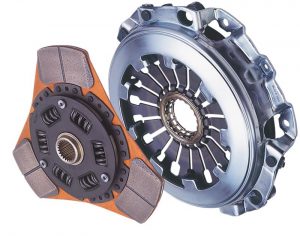
And their fuel economy, though higher, isn’t all that much higher: 21 city, 29 highway with the manual transmission.
Put another way, you get 127 more hp, 122 additional ft.-lbs. of torque – and get to 60 a solid second-plus earlier (a difference that is very seat-of-the-pants noticeable) at the cost of 3 MPG in city driving and 3 MPG on the highway – a difference that isn’t noticeable unless you are really keeping track of it.
Those are the upsides.
ON THE ROAD
The Z began life as a sports car – light and agile more than quick. Arguably, it was the original Miata. A well-built alternative to the high-powered but clumsy American stuff – and the poorly built Italian and British stuff.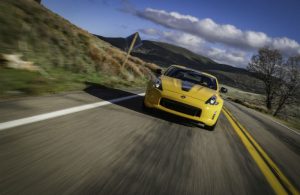
A 1969 240Z weighed about 1,100 lbs. less than the current 370Z. It had a single overhead cam straight six making 161 hp under the hood – exactly half the power made by the current car’s V6.
It couldn’t run with the V8 muscle cars of the time in a straight line – but in the curves, it could leave them floundering. The original Z car was also inexpensive, wife-drivable and commute-friendly. It had good brakes – rare, in the early ’70s – and got good gas mileage, too.
This car sold like funnel cakes at the state fair.
As the 70s rolled on, the 240 became the 260 and then the 280ZX. It got heavier and less agile and more expensive. At one point, they even added back seats.
Then came the 300ZX – including one with twin turbos. It was even heavier and though it was a ripper, sales flagged. That car got cancelled.
The current 370Z is caught in between worlds. It is closer in many ways to the original/minimalist 240Z than to the gaudy 300ZX. But it is still trying to be at least partially a high-powered GT (like the Corvette) that is also still a sports car.
Thus the problem – as far as sales.
Though you can buy one for under $30k – and that’s not too far away from the price of a BRZ or Miata/Fiata – it’s very easy to pay closer to $40k.
And that puts the car too close to the Corvette.
Engine/power/acceleration stack-ups ensue. We know who wins that one.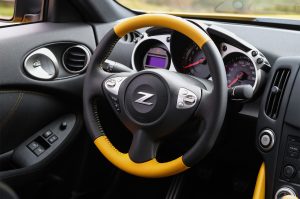
And even though you can buy a Z for under $30k – and get more engine/power/acceleration than the BRZ and Miata offer – you’re still getting a much heavier, more aggressive-feeling (and looking) car that’s a very different kind of car than a BRZ/86 or Miata/Fiata.
Or for that matter, a 240Z.
Arguably, Nissan either over-engined the current Z.
Or under-engined it.
This is not my personal opinion but rather the verdict of the market, as expressed by sales. So far this year, about 400 Z cars find homes each month. That works out to about 8-10 per state. For perspective, Chevy sells about 2,500 Corvettes each month. Mazda is closing in on the millionth Miata.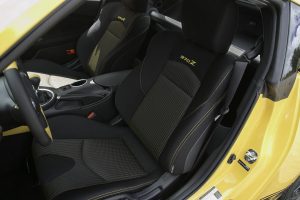
It’s a shame because the 370s is a lot like a front-engined Porsche 911 – and for a lot less money. It has the cornering reflexes of a chased rabbit and there is enough power to leave the line with both tires making smoke (forget about this in the BRZ/86).
The engine will spin to almost 8,000 RPM – the free-revving enhanced by an ultra-lightweight carbon fiber driveshaft.
The action of the six-speed manual is as mechanically gratifying as the action of a custom Kimber 1911 .45 with a 3 pound trigger. The throttle blipping/rev-matching downshifts will make you feel – and look – like a pro. The steering is laser-sight accurate, the chassis willing, the grip threshold seemingly limitless.
Opposite-locked, tail-out – it delivers.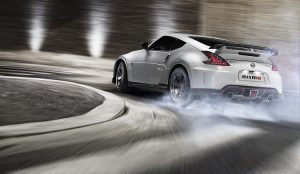
And yet, it doesn’t have the following you’d think it would.
Perhaps 400 hp would solve the problem. Or – on the other end of the scale – a 250 hp six and a starting price around $25k?
That might be the sweet spot Nissan hasn’t managed to hit dead-on since the days of the 240/260Z.
Dimensionally, the 370 Z is much smaller than the Corvette: 167.5 inches long, 100.4 inch wheelbase vs. 177.9 and 106.7 for the Chevy.
The more compact size of its V6 (vs. the Corvette’s V8) allows a relatively short nose – and the wheel centerlines being more than six inches closer makes it look (and feel) much more compact than the Corvette – which is a pretty big car.
The Z’s proportions are much close to those of the BRZ/Toyota 86 – which are 166.7 inches long overall and ride on a 101.2 inch wheelbase. But the Z has about an inch more headroom (38.2 inches vs. 37.1) and though it doesn’t seem like much of a difference, for taller drivers, an inch (plus or minus) can be a deal-breaker.
Naturally, the trunk is tiny: 6.9 cubic feet. But the liftback layout (like Corvette) makes it feasible to carry unwieldy objects. Also, Nissan includes storage bins and cubbies sprinkled here and there, including behind the front seats – and while they may not have much room individually, collectively (if you’re creative) you can pack a Z with more stuff than you’d expect. For example, several cups of coffee – a feat made doable by the large, molded-out lowers built into each door panel.
The vibe of the interior is Dark Knight serious. Matte black and nickel finishes. All-analog primary gauges dominated by a centrally mounted tach with the speedo off to its right. On the dashtop and canted toward the driver are three secondary gauges, including oil temperature (but oddly, not pressure).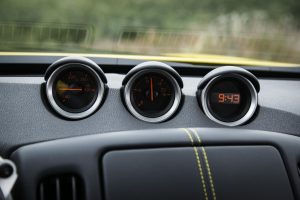
Secondary controls (AC, heat, fan speed, stereo) are hand-operable without looking at them. Forward visibility is good, but the view to the sides and rear is what you’d expect given the squeezed-back side glass and steeply sloped rear glass.
Nismo trims get a set of Alcantara suede-trimmed Recaro sport buckets and matching Alcantara suede-trimmed steering wheel – as well as wild-looking body kit (different front and rear fascias, with a deep chin spoiler and air diffusers) plus a different and – ironically – a more subtle decklid spoiler.
If you want something in the middle – more performance than the base car but not quite as expensive as the Nismo – go with the Sport package. It adds the upgraded brakes (14 inch powder-coated calipers in lieu of the otherwise standard 12.6 inch calipers), ultra-light 19-inch wheels with “summer” high-performance tires plus a limited slip differential and a deeper chin spoiler.
Remember: It’ll still be about as quick as the more expensive Nismo version.
THE REST
Nissan is on the right track, I think, with the Heritage Edition – as a concept.
It is an attempt to track the car back to its 240/260Z roots as a simpler – and more affordable – car.
A lighter car would be even better.
It would be interesting to see a cafe racer version of the Z – like the Heritage Edition as far as the visuals, but shorn of price and weight-padding equipment that have fluffed up the Z-car’s price tag and added four figures to the car’s curb weight since the days of the 240Z.
Imagine a 2,800 lb. Z with a $26k price tag. It would make cars like the BRZ/86 look silly, cream the Miata/Fiata – and make a Corvette look like an overpriced Viagra-mobile.
Better than funnel cakes at the fair.
THE BOTTOM LINE
The Z car deserves a reboot – not retirement.
Hopefully Nissan will realize this and not turn out the lights.
If you like what you’ve found here, please consider supporting EPautos.
We depend on you to keep the wheels turning!
Our donate button is here.
If you prefer not to use PayPal, our mailing address is:
EPautos
721 Hummingbird Lane SE
Copper Hill, VA 24079
PS: EPautos stickers are free to those who send in $20 or more to support the site. Also, the eBook – free! – is available. Just enter you email in the box on the top of the main page and we’ll send you a copy ASAP.


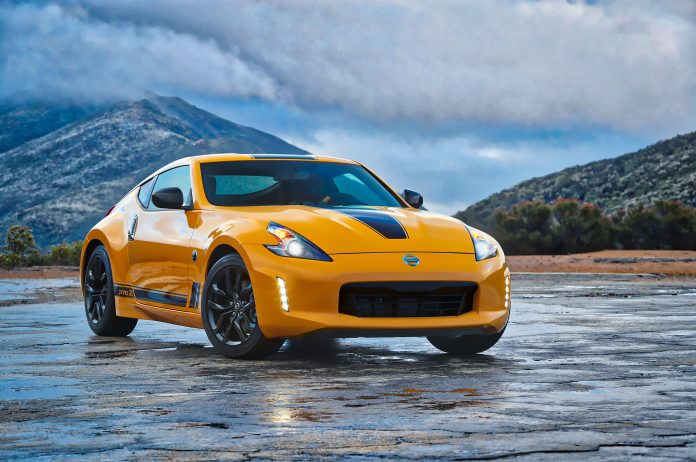





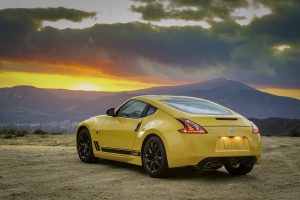







Any chance you’ll be reviewing the new Z soon? I miss my ’90 Twin Turbo sometimes….
Hi Michael,
I’m hoping I get one before the weather turns!
Eric, thanks for a great review. There is a Black 370Z in my neighborhood and I think it’s a beautiful car. Way different from a Miata, but a worthwhile alternative.
Talk about an aged relic. I was a Datsun fan from day 1. Rallied a 510 in the 70’s. Then in 1990, I saw an old Bluebird roadster for sale and had to have it. But I didn’t do my homework. I bought the 1967 1600 model, not knowing that the 1967.5 model was the first one with the overhead cam engine. So I got the tractor engine version. Bummer! Then I saw the 2000; that was a very sad day.
But I enjoyed my pushrod 1600 for what it was. Drove it to work every day, usually with the top down. I found a shop with an 80-year old mechanic who could work on it and he kept it going for years. That manual 4-speed was the slickest gearbox ever. And the noise! The wail! Nirvana.
Then a gearhead buddy of mine, a Lotus mechanic and collector, had a baby, a son, and he started bugging me to sell him the Datsun. So it went to a good home.
I had a 1969 240 z. The serial number was just over 1000, so they were still working some of the bugs out of it; still a pretty nice car. It was a hand-me-down from my dad. He paid $2,500 for it brand new. I sand blasted it, painted it fire engine red, tossed some rims on it along with webers, headers,an exhaust system, and ground effects. I thought it looked great. My dad said, “Underneath it’s still just a tired old car.” There’s something to that, but what I hear you and others here saying is not much different than what I would do. I’d just take an old z and rebuild it from the ground up just the way I want it. It could probably be done for less than $30k and you’d have a brand new classic with great power and handling.
A friend of mine had one just like mine except that he had considerably more money into his motor and suspension. You could see if you had spinach between your teeth just looking at the valve cover. That thing was a rocket.
I’ve always liked the styling of the original Z. The 350 and 370 z’s are great looking as well, but I don’t like the lines as much as the original Z. I don’t like the price or the unreliability either. I was looking at buying a used one a while back, but I had gotten used to the reliability of my economical Hyundai Elantra. I had beaten that car mercilessly and she never complained. The newer ones were good, but I noticed that the sports car Hyundai was selling had a nice sticker price so I bought a used Genesis coupe. It had that same Z styling and that same cheap Z price tag as well.
I also like being able to customize my car to the look I like, and spending a small fortune on some of these cars doesn’t leave me with many options so I bought some rims, a custom exhaust, and that’s about it so far. I now have the Z I always wanted at a fraction of the price I would have paid. I’ve got one of the best warranties in the country too. These cars will easily run a few hundred thousand miles without so much as a cough or a sniffle. It has a roomy backseats, but doesn’t look like those gay 2+2 z’s they came out with. I’ve driven from Florida to California (2,780 miles) in 44 hours with an 8 hour stop in Sonora Texas. Two 18 hour days behind the wheel and no aches or pains whatsoever. I’ve got the sport package and it’s still probably the most comfortable car I’ve ever owned.
I haven’t compared it to the BRZ or the FRS, but those are essentially the only other cars I would have considered if I hadn’t bought this car. I did sit in a FRS though and didn’t like the head room. It was an instant deal breaker for me. I’ve been in a corvette as well and also felt a bit cramped. A friend of mine has a Mustang that is only a few years old; bought it new. It sounds like someone threw a bunch of nuts and bolts into the door panels, the muffler, etc. Just rattles like it’s some old rusty truck about to fall apart. The Mustang was the only other viable option for me. I like the looks and that muscle car growl. I like the sound of the Mustang so much that I found some old aftermarket resonators off a Mustang and welded them on so I now have the best of both worlds. I have a reliable sports car with that Mustang muscle car sound.
Hi Teo,
I love the early Zs.
Growing up, a neighbor friend’s dad had one – a 260Z. We would pop the hood and marvel at the straight six, move the driver’s seat forward enough so that our legs could reach the pedals and pretend to drive it.
I’d love to have one now. So much potential – which is one of the things I like about the cars from that time. The new cars are much more powerful and so on as they come, but their complexity and cost discourages mods. They can be done, of course – but it’s not the same thing. Rejetting and tuning a pair of carbs can be done for $20 in parts; putting a header on an old Z is a couple hours’ work with basic hand tools. Putting a new cam in the six involves no “remapping” of a got-damned computer and no worries about whether the stick has too much overlap and will foul the catalyst and 02 sensors.
God, I miss those days.
I had mine for about 5 years before I wrecked it. I really loved that car. They have a distinctive sound. It’s unmistakable. If I hadn’t wrecked it, I would have put some fender flairs on, some big meaty tires, and probably gone bananas on the engine. I could practically hang my legs down in the engine compartment to work on it. Today there’s so much crap in an engine compartment you can barely get two fingers into it. That car was incredibly fun to drive, and almost as fun to work on. It had a rudimentary smog system that could be bypassed in about five minutes. I got the car when I was a sophomore in high school, but didn’t fix it up until I was a senior. I was styling back then, those were the days…,
I’ve seen non running z chassis selling for over $3k. Fixed up stock Z’s going for $25k You can still find nice rust free models sitting out in the desert in Arizona…
I would have had a ’67 if it hadn’t been for my mother. I loved those cars and knew plenty other people who did. Seems like there was somebody in the crowd always had one or a 260 and then 280’s but after that, I’m not sure what happened but that seemed to be the end of it. The 280 just seemed to be big and heavy….and complex. But still, the 240 was a looker and a driver and I’d have been glad to have one. Then the price started going up.
Speaking of Jap Tech…
Mazda announces breakthrough in long-coveted engine technology
Its homogeneous charge compression ignition (HCCI) engine ignites petrol through compression, eliminating spark plugs. Its fuel economy potentially matches that of a diesel engine without high emissions of nitrogen oxides or sooty particulates.
Mazda stock is down 3% from 1725 JPY to 1669 JPY since the announcement. As a conspiratologist might expect:
Hi Tor,
The gas compression ignition engine is an interesting idea; I’m looking forward to test driving a car with such an engine. I’m wondering, of course, whether the operating characteristics will be agreeable to buyers. I suppose they can suppress/tamp down the noise with insulation. And if the powerband is like a diesel’s, people (most people) may prefer this design, with its superior low-end torque.
I mentioned this in my review of the 2018 Tiguan.
Mr Fuzz seemed to like it LoL
I think this car is great. If there really hasn’t been any updates since the 370z debut all they need to do is figure out how to get the starting price point down to 25K and also boost the actual performance of the nismo version. Everyone is going turbocharged these days do the same thing and throw in awd from the old g37x platform. Make it a common man’s GTR. If they wanna save gas throw in a cvt option for the posers.
One of the college girlfriends had a 240. That and the 260 are what I remember as being “Z” cars. The later twin-turbo cars were certainly faster. And the new 350/370 were better still. But they don’t match the feel or look of the originals.
I will point out that an inline-six, besides being naturally balanced, is a good candidate for turbocharging, as it has a cold and a hot side. So all you need to do is run the intake over the top to get to a turbo outlet and so the packaging is much better.
The other issue with the new cars is the proportions are all wrong – they look like bars of soap. This results in them having huge blind-spots. I nearly changed lanes into a car during a test drive – and learned that in these cars you accelerate in order to assert dominance and take your lane. 😉 The originals were simply better looking cars.
“The Z car deserves a reboot – not retirement.”
Exactly that. I considered buying one instead of my 2015 Mustang until I looked at the numbers vs price.
I’m surprised nobody mentioned the Mitsubishi 3000 GT. I’ve seen some outrageously powerful examples. People who owned them often did suspension mods too and they fairly much left everything else in the weeds. I didn’t say they were cheap but probably the best bargain out there to eat the Corvette crowd.
Of course it caught me spending every nickel on big 4WD pickups, tractors, implements and cattle and trying to find grazing since we were 4 years into a drought that didn’t break for another 14 years. Yes, I’m still looking for my ass I lost back then.
Hi Eight,
My bad – and you’re right!
I took one – twin turbo press car – the other side of 160…
Yep eric, the way they’d pull themselves around curves and respond to the throttle was amazing. I wanted one badly…..
Dammit!!!!
You didn’t mention the Toyota MR2, second edition. I owned a ’91, mid-engined, gussied up with a dial-up turbo boost kit (21 psi, triple the stock pressure), off-road exhaust, Eibach suspension, etc. It cornered like a dream, and I greatly enjoyed blowing off 5-liter Mustangs on Saturday nights. The fit and finish were amazing as well. Girls liked it too. 🙂
Hi Karalan,
Yup, the MR2 was a great car; a Porsche Boxster without the Porsche price!
When the Z was revived back in 2002 as a 2003 model it sold pretty well. There wasn’t much else out there in the same ballpark except, perhaps, the Mazda RX-8, which was a different sort of sporty car (much less powerful, rear seat, ugly). The original Z was a budget Porsche 911 in many ways, but as you said it slowly became bloated and more expensive until the 300Z twin turbo, which was a great car in its own right, was just too expensive for what it was at the time and they suspended it until the 2003 model 350Z.
At the time, Fox body Mustangs were extremely long in the tooth and Camaro was dead. The RX-8, which came out a little later, was underpowered, dog slow, but handled well and had a high-revving Wankel rotary engine. It also had a back seat and a third door, for better or worse. We were still coming out of the 90s malaise and cars that were sexy, handled well, and were affordable. The 350Z was an attempt to recreate the original Z formula, and it was partially successful.
Unfortunately Nissan then proceeded to neglect the Z. Essentially no updates happened for the rest of the 350Z’s lifespan and it rapidly aged. Then the 370Z came out in 2009 and everyone thought it was just a 350Z with slightly goofier headlights when, in fact, it was an updated (and smaller/lighter) platform. Unfortunately, it clung to the same aging VQ engine that everything else Nissan built also used, from the Maxima to the Murano to basically even the Frontier pickup. It was not able to keep up with the industry in terms of power output or fuel economy. Add to this that both the 350Z and 370Z were notoriously unreliable, as Nissan reliability as a whole plummeted under its new owner Renault, and more interesting hardware was cropping up elsewhere, particularly out of Detroit.
Adding insult to injury, Nissan came out with Godzilla, the GT-R powered by a turbocharged variant of the same engine under the 370Z’s hood. Every year the GT-R got better and better, more and more powerful, and continued to slay giants at the track. One favorite story was that Ferrari engineers at a famous American race track where there was a best driver’s car comparison test going on had accurately modeled every car running in that competition, including a Ferrari model, and predicted how well each would perform on the track to within a reasonable margin of error. All, that is, but one. The GT-R consistently lapped far faster than Ferrari’s computational models predicted, as if it was breaking the laws of physics. They literally could not understand how this behemoth was faster than everything else out there around the track. But it was. And every year since it has gotten faster. And every year the 370Z has remained essentially untouched.
Essentially the 370Z is competing against modern hardware using 2003 era technology (the 370Z, though new, was not significantly improved over the 350Z). Most importantly, it was being asked to compete with pony cars from Ford and Chevy that had undergone not one, but two generational updates during that time. Both the Mustang and Camaro start out cheaper than the 370Z and top out much more expensive, and their current levels of performance match or exceed that of the 370Z for less money, not to mention the supercar levels of performance achievable with the higher priced options in the same family. While it’s true the pony cars are slightly larger, they are not large cars by any means (nor is the Corvette, which is similarly sized to the Porsche 911). Plus they have a back seat, sort of, and a trunk which, combined, offer more practicality.
In reality, the Z was allowed to die years ago by a Nissan more concerned with its halo car, the GT-R, than paying attention to what the rest of the market was doing. Now we have much cheaper 4-cylinder cars encroaching on 370Z performance territory, cars costing less that match or exceed its performance, and all are styled more freshly than the Z. I think Nissan would better utilize its resources to develop new, competitive cars and trucks and once back on firmer footing revive the Z again in a few years.
Nissan’s new Titan and Titan XD are off to a pretty bad start, garnering mediocre reviews and a reputation for unreliability (despite a long warranty). They killed off the XTerra and the Frontier is in dire need of an update, or to be put to sleep one. The Altima, which was competitive when it first came out, is now near back of the pack compared to Accord, Camry, Mazda 6, and others. The Maxima has received a lukewarm reception despite being competent. And most of their other models are dated, underwhelming, and noncompetitive. As far as I can tell, their only interesting models are the GT-R, the “new” Armada, and the Murano. That’s one SUV, one crossover, and one aspirational supercar-killing sports car. That’s it. If Nissan doesn’t up their game, and ditch the French/Renault negative influence quick, they might not be around much longer. If it weren’t for the international markets where they have some better competing models, they’d be in deep trouble.
Hi SJ,
Spot on.
The shame of it is the “fix” would – I think – be fairly easy. As I wrote, my approach would not be to compete directly with Corvette but instead, target the BRZ/86 by offering the power/acceleration they lack at a price point that’s in the same ballpark. The Z feels/drives more like a sports car (like the BRZ/86) than the Corvette – and would feel more so if it were lightened up by several hundred pounds. Then get rid of the extraneous luxury-pretentious equipment or make it optional. Give it a six pack. Tone it. The car’s looks are not the problem – and I don’t think its V6 (though shared with other Nissans) is a problem, either. Consider that the Corvette’s engine is also used in Chevy trucks and Cadillac SUVs!
I hate to see them give up on the car when it’s a good car, basically – and a fixable car, too.